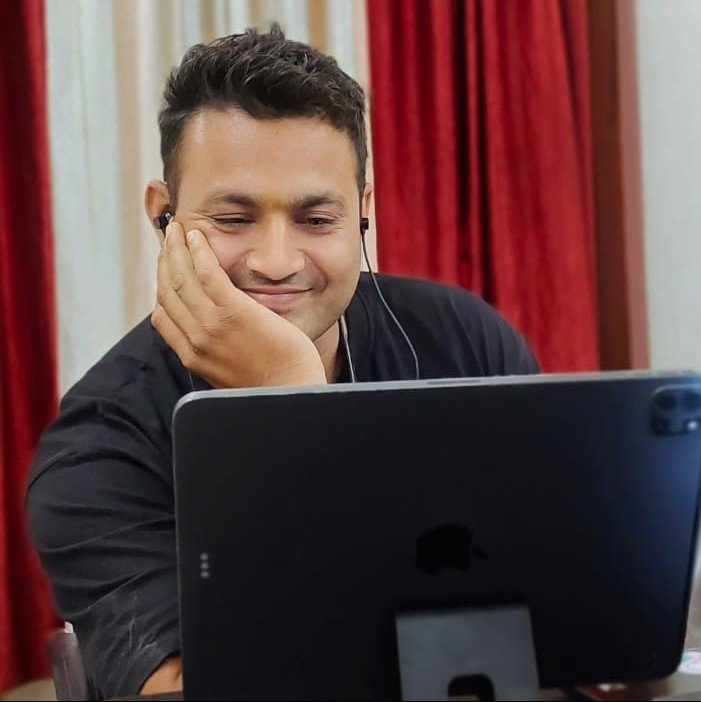Master Marko JS in Jaipur, Rajasthan at Groot Academy
Welcome to Groot Academy, Jaipur's premier institute for IT and software training. We are proud to offer the best Marko JS Course in Jaipur, Rajasthan. Whether you are a beginner or looking to enhance your skills, our comprehensive course is designed to provide you with the knowledge and hands-on experience needed to excel in web development with Marko JS.
Course Overview:
Are you ready to become proficient in Marko JS, a powerful templating engine for creating dynamic web applications? Join Groot Academy's best Marko JS course in Jaipur, Rajasthan, and transform your web development career.
- 2221 Total Students
- 4.5 (1254 Ratings)
- 1256 Reviews 5*
Why Choose Our Marko JS Course?
- Comprehensive Curriculum: Our course covers everything from the basics of Marko JS to advanced topics such as server-side rendering, component creation, and performance optimization.
- Expert Instructors: Learn from industry professionals with extensive experience in Marko JS and web development.
- Hands-On Projects: Gain practical experience by working on real-world projects and assignments that enhance your skills.
- Career Support: Access our network of industry connections and receive personalized career guidance and placement assistance.
Course Highlights
- Introduction to Marko JS: Understand the fundamentals of Marko JS, including its syntax, components, and templates.
- Advanced Marko JS Features: Dive into advanced topics like asynchronous rendering, component lifecycle management, and optimization techniques.
- Practical Applications: Implement Marko JS concepts through hands-on projects and case studies to build interactive web applications.
Why Choose Our Course:
- Expert Instruction: Our experienced instructors provide real-world knowledge and insights, guiding you through each concept with clarity.
- Hands-On Projects: Apply theory to practice with projects that simulate real-world scenarios, developing a strong portfolio of work.
- Personalized Learning: The course is designed to accommodate various learning styles and paces, ensuring thorough understanding of concepts.
- Career Relevance: The skills gained are applicable across various web development domains, forming a solid foundation for further career growth.
Who Should Enroll?
- Web developers seeking to expand their skillset
- Software engineers interested in Marko JS
- Developers aiming to build dynamic web applications
- Entrepreneurs planning to create Marko JS-based projects
Why Groot Academy?
- Modern Learning Environment: Enjoy state-of-the-art facilities and resources designed for effective learning.
- Flexible Learning Options: Choose from weekday and weekend batches to fit your schedule.
- Student-Centric Approach: Benefit from small batch sizes for personalized attention and effective learning.
- Affordable Fees: Take advantage of competitive pricing with flexible payment options.
Enroll Now
Begin your journey to mastering Marko JS with Groot Academy. Enroll in the best Marko JS course in Jaipur, Rajasthan, and take the first step toward a successful career in web development.
Contact Us
- Phone: +91-8233266276
- Email: info@grootacademy.com
- Address: 122/66, 2nd Floor, Madhyam Marg, Mansarovar, Jaipur, Rajasthan 302020
Instructors

Shivanshi Paliwal
C, C++, DSA, J2SE, J2EE, Spring & Hibernate
Satnam Singh
Software ArchitectA1: Marko is a modern templating engine for building dynamic web applications. It allows developers to create efficient and scalable front-end components.
A2: Marko offers high performance and easy integration with other libraries and frameworks. It focuses on server-side rendering and is designed for speed and simplicity.
A3: Key features include server-side rendering, reusable components, and support for asynchronous data loading.
A4: Marko was created by eBay as a solution to their front-end performance challenges and has since evolved with contributions from the community.
A5: Marko is ideal for projects requiring high performance and scalability, especially where server-side rendering is crucial.
A6: Yes, Marko is designed to handle large-scale applications efficiently with its performance-oriented architecture.
A7: Basic knowledge of HTML, CSS, and JavaScript is recommended.
A8: The official documentation is available on the Marko website and GitHub repository.
A9: Start by setting up a Marko development environment, exploring basic tutorials, and building simple components.
A1: Core concepts include components, templates, data binding, and the Marko syntax.
A2: Marko components encapsulate HTML, CSS, and JavaScript into reusable modules that can be easily integrated into your application.
A3: Marko syntax includes HTML-like tags with embedded JavaScript expressions for dynamic content.
A4: Data binding allows components to react to changes in data automatically, updating the UI without manual intervention.
A5: Templates define the structure and layout of components, combining static HTML with dynamic data.
A6: A simple component can be created using the Marko component syntax and including it in your application’s templates.
A7: Benefits include improved performance through server-side rendering and easy-to-maintain code with reusable components.
A8: Events are handled using Marko’s event system, which integrates with standard JavaScript event handling methods.
A9: Yes, components can be nested within each other to build complex user interfaces.
A1: A Marko component is a reusable piece of UI that combines HTML, CSS, and JavaScript into a single module.
A2: Components are defined using the `.marko` file format, which includes HTML and embedded JavaScript.
A3: Data is passed to components through attributes and can be accessed within the component using JavaScript expressions.
A4: Lifecycle methods include `onCreate`, `onMount`, and `onDestroy`, allowing you to manage component states and behavior.
A5: Components can be reused by including them in other components or templates using the Marko syntax.
A6: The `template` function defines the structure and layout of the component, integrating dynamic content.
A7: Component state is managed using properties and local variables within the component.
A8: Components can be styled using CSS, inline styles, or by including external stylesheets.
A9: Component composition involves combining multiple components to build complex UIs, enhancing modularity and reusability.
A1: State is managed using component properties and internal state variables, which can be updated and used for rendering.
A2: Component state is local to a specific component, while application state is global and shared across multiple components.
A3: State is updated by modifying component properties or internal variables and re-rendering the component as needed.
A4: Best practices include keeping state minimal, using efficient update methods, and avoiding unnecessary re-renders.
A5: Efficient state management ensures smooth performance by minimizing unnecessary updates and re-renders.
A6: State management libraries help handle global state and complex state interactions. For simple applications, Marko's built-in methods may suffice, but libraries can be used for larger projects.
A7: Asynchronous state updates can be managed using JavaScript’s async/await or promises, ensuring state consistency.
A8: Props allow components to receive and manage state from parent components, facilitating data flow and state management.
A9: Testing can be done using unit tests to verify state changes and ensuring the component behaves as expected.
A1: SSR in Marko involves generating HTML on the server and sending it to the client, improving performance and SEO.
A2: Advantages include faster initial load times, improved SEO, and better user experience.
A3: SSR is enabled by configuring your Marko application to render components on the server side and serve the generated HTML.
A4: Challenges include managing server resources, ensuring compatibility with client-side interactions, and handling dynamic content.
A5: Performance can be optimized by caching rendered content, minimizing server processing time, and using efficient rendering techniques.
A6: SSR provides a fully-rendered HTML page on the initial load, and client-side interactions are handled after the page is loaded.
A7: Tools include Marko’s built-in SSR capabilities, server-side frameworks, and caching mechanisms.
A8: Routing is managed by defining server-side routes that render the appropriate Marko components based on the URL.
A9: Best practices include optimizing rendering performance, ensuring compatibility with client-side code, and using caching strategies.
A1: AI libraries can be integrated by including them in your project and using their APIs within Marko components to add intelligent features.
A2: Popular AI libraries include TensorFlow.js, Brain.js, and Synaptic.
A3: TensorFlow.js can be used by importing it into your Marko project and utilizing its functions to build and deploy machine learning models.
A4: Benefits include enhanced user experiences, personalized content, and advanced analytics capabilities.
A5: Data processing can be handled by preparing and cleaning data on the client or server side before feeding it into AI models.
A6: Challenges include managing performance, ensuring compatibility with AI libraries, and handling large datasets.
A7: Security can be achieved through encryption, secure API access, and managing data privacy.
A8: Best practices include optimizing model performance, ensuring data accuracy, and providing clear user interfaces for AI features.
A9: Testing involves validating AI model predictions, ensuring accurate data processing, and checking integration points between AI components and the application.
A1: Machine learning is a subset of artificial intelligence where algorithms are used to learn from data and make predictions or decisions without explicit programming.
A2: Types include supervised learning, unsupervised learning, and reinforcement learning.
A3: Marko developers can use machine learning to enhance applications with features like recommendation systems, predictive analytics, and natural language processing.
A4: Common algorithms include linear regression, decision trees, clustering algorithms, and neural networks.
A5: Models are evaluated using metrics such as accuracy, precision, recall, F1 score, and confusion matrix.
A6: Data is crucial as it is used to train and test models, and the quality of the data directly affects model performance.
A7: Overfitting can be managed through techniques such as cross-validation, regularization, and pruning.
A8: Tools include TensorFlow.js, Brain.js, and Synaptic.
A9: Integration is done by utilizing machine learning libraries within Marko components and using their APIs for data processing and predictions.
A1: Marko handles data through component properties, state management, and data binding techniques.
A2: Data can be fetched using APIs, and Marko components can utilize async/await or promises to handle asynchronous data retrieval.
A3: APIs provide a way to interact with external services and retrieve or send data for use within Marko applications.
A4: API responses are managed by processing the data and updating the component state or properties as needed.
A5: Errors can be handled using try/catch blocks, error messages, and fallback mechanisms to ensure a smooth user experience.
A6: Best practices include securing API endpoints, validating data, and handling errors gracefully.
A7: Integration involves using HTTP requests to communicate with third-party APIs and processing the responses within Marko components.
A8: Tools include Postman for testing APIs, and libraries like Axios or Fetch for making HTTP requests.
A9: Data consistency can be ensured by validating and sanitizing data before use and implementing reliable data handling practices.
A1: Common issues include slow rendering, inefficient data handling, and excessive client-side processing.
A2: Optimization can be achieved through techniques such as server-side rendering, minimizing re-renders, and efficient component updates.
A3: Tools like Chrome DevTools, WebPageTest, and Lighthouse can be used for performance profiling and analysis.
A4: Data handling can be optimized by using efficient data structures, minimizing data processing on the client side, and implementing caching strategies.
A5: Code splitting allows loading only the necessary parts of the application, reducing initial load times and improving performance.
A6: Performance can be improved by optimizing component rendering, avoiding unnecessary state updates, and utilizing component lifecycle methods effectively.
A7: Best practices include efficient data handling, minimizing DOM manipulations, and leveraging server-side rendering.
A8: Performance improvements can be measured using performance metrics and tools, and tracking can be done through regular profiling and analysis.
A9: Scalability can be ensured by following best practices, optimizing performance, and designing the application to handle increasing loads efficiently.
A1: Steps include preparing the application for deployment, configuring the server environment, and deploying the application to a hosting platform.
A2: Deployment involves ensuring AI models and libraries are included, configuring server resources, and testing the AI features in the deployed environment.
A3: Considerations include server capacity, model performance, and integration with the application.
A4: Security can be ensured through encryption, secure API access, and regular security audits.
A5: Tools include Docker for containerization, Kubernetes for orchestration, and cloud platforms like AWS, Azure, and Google Cloud.
A6: Monitoring can be done using tools like New Relic, Datadog, and cloud provider monitoring services to track application performance and health.
A7: Best practices include thorough testing, managing dependencies, and ensuring scalable infrastructure.
A8: Updates and maintenance can be managed through regular patches, version control, and monitoring for any issues post-deployment.
A9: Challenges include managing resource requirements, ensuring model performance, and handling deployment-specific issues.
Anita Sharma
Rajesh Kumar
Meera Patel
Sandeep Verma
Nisha Gupta
Amit Joshi
Pooja Arora
Vikram Singh
Divya Mehta
Rajiv Agarwal
Simran Kaur
Karan Patel
Riya Jain
Aakash Sharma
Get In Touch
Ready to Take the Next Step?
Embark on a journey of knowledge, skill enhancement, and career advancement with
Groot Academy. Contact us today to explore the courses that will shape your
future in IT.


